"When ... the Guard meets ... the Line en route,
the latter shall form in line of battle and port arms
or present sabers ... Flags and standards shall be dipped,
The colonels and commanders shall exchange salutes."
|

The Cavalry of Imperial Guard.
"An old adage runs: 'There is no temple without a God
and no throne without a Guard.' But there are guards and Guards."
- Henri Lachoque
 In 1796 the Guard of the Directory was formed to escort the Directors in public ceremonies and parades. These guardsmen were 5'10" tall, literate, with perfect conduct and participated in at least 2 campaigns. These men were the elite of the army and formed 2 companies of foot grenadiers and one squadron of horse grenadiers. The horse grenadiers wore aiguillette on the right shoulder. It was the distinctive insignia of Guard cavalry.
The Guard drew extra pay and allowances, additionally they got better housing and enjoyed
the highest prestige. The guardsmen were forbidden, under pain of dismissal, to tend an
officer's horse, or even hold it by the bridle.
In 1796 the Guard of the Directory was formed to escort the Directors in public ceremonies and parades. These guardsmen were 5'10" tall, literate, with perfect conduct and participated in at least 2 campaigns. These men were the elite of the army and formed 2 companies of foot grenadiers and one squadron of horse grenadiers. The horse grenadiers wore aiguillette on the right shoulder. It was the distinctive insignia of Guard cavalry.
The Guard drew extra pay and allowances, additionally they got better housing and enjoyed
the highest prestige. The guardsmen were forbidden, under pain of dismissal, to tend an
officer's horse, or even hold it by the bridle.
1800
| |
Squadrons |
| Horse Grenadiers |
2 |
| Horse Chasseurs |
1 |
|
In 1802 Napoleon submitted a permanent schedule of recruitment: 2 men from each cavalry
regiment, tall, robust, of exemplary conduct, able to read and write and who participated
in at least 3 campaigns. In 1806 each cavalry regiment was ordered to send 6 best men to the
Guard.
The candidates from the hussars were at least 170 cm tall,
from chasseurs and dragoons 173 cm, and candidates from
cuirassiers and carabiniers 176 cm tall.
In September 1805 was issued decreee:
“Art. I - A corps of horse vélites will be formed with 800 men.”
“Art. II - This corps will be composed of conscripts from the 3 last years, at a rate of 6 per Department,
taken among those who come forward voluntarily, or, failing this, indicated by the prefect.”
“Art. III - Among the 6 vélites provided by each department, three must be 5' 4" tall, and three 5'5" tall and above.”
“Art. IV- The vélites will have to be well to do and to have, by themselves or their parents, an assured income
300 francs per annum.”
“Art VI - The corps of the vélites with horse will be divided into 8 companies."
“Art. XII - Those of the vélites who are distinguished by their control, their aptitude and their behavior,
could be allowed in the Imperial Guard before having reached the age and the number of years of service required
to belong to the aforementioned Guard.”
The Velites were created from conscripts with an income of 300 francs who could
produce a pair of buckskin breeches, gauntlets and boots. There were 400 Velites
for grenadiers and 400 for chasseurs. The vélites were admitted in the regiments of horse grenadiers and horse chasseurs and
formed V and VI Squadrons.
Theoretically after 3 or 5 years all the velites became second lieutenants of the line cavalry regiments.
1805
| |
Squadrons |
Squadrons of
Velites |
Regiment of
Horse Grenadiers |
4 |
2 |
Regiment of
Horse Chasseurs |
4 |
2 |
| Elite Gendarmes |
1 |
- |
| Mamelukes |
0.5 |
- |
|
Each squadron had 2 companies. Each company had: 1 Capitaine, 2 Lieutenant en premier,
2 Lieutenant en second, 1 Marechal-des-logis-chef, 6 Marechaux-logis, 1 Fourrier, 10 Brigadiers, 3 Trompettes, 1 Marechal-ferrant (blacksmith),
96 Privates. (In 1813 each company had 4 Marechaux-logis instead of 6, and 8 Brigadiers
instead of ten.)
 In 1806 was formed third regiment, the Guard Dragoons -->
In 1806 was formed third regiment, the Guard Dragoons -->
(Regiment de Dragons de la Garde Impériale).
In 1807 fourth unit was raised, the Polish Guard Lighthorse
(Regiment de Chevau-Légers de la Garde Impériale Polonais).
In 1807 it was ordered that all cavalry regiments will send approx. 700 bravest soldiers
who had distinguished in battles regardless of their length of service.
In 1810 fifth regiment was formed, the Dutch lancers.
(2e Regiment de Chevau-Légers Lanciers de la Garde Impériale).
In December 1811 Napoleon wrote to his Chief-of-Staff Marshal Bessieres:
"I see that thanks to your efforts the cavalry strength
of Guard amounts to 6.450, or 400 men short of establishement. I have decreed that the following regiments shall each provide 10 men of the
required quality, to wit the 1st, 2nd, 3rd, 4th and 10th Hussars, and the 10th, 13th, 14th,
15th, 22nd, 26th, 27th, 29th and 30th Chasseurs, totalling 140 men.
These men will be taken from the regimental depots, and if enough men of the required quality
are not available at the depots, then the shortfall will be made up from the combat squadrons
in Spain.
The 20 dragoon regimentsd serving in Spain will each provide 10 men, making another 200.
The 16 regiments of cuirassiers and carabiniers will each provide 6 men, making another
96. As for the 60 men needed to complete the 2nd Lighthorse (Dutch Lancers),
the Velites will provide them."
 Picture: Guard Dragoons and Napoleon in burning Moscow, 1812.
Picture: Guard Dragoons and Napoleon in burning Moscow, 1812.
Some time before the campaign in 1812 in Russia the Guard was ranked into three categories:
Old, Middle and Young Guard. The Old Guard enjoyed the highest prestige, in 1811 Napoleon
made it clear to Berthier (chief-of-staff) "I wish it clearly understood that this priviledge
doesn't apply to the 2nd Grenadiers and 2nd Chasseurs, nor to the Fusiliers (Middle Guard),
voltigeurs and tirailleurs (Young Guard) nor the 2nd Lighthorse-lancers ("Red Lancers"). ...
Keep this decision for your guidance alone."
Old Guard:
. . . . Regiment of Horse Grenadiers
. . . . Regiment of Horse Chasseurs
. . . . Regiment of 1st Lancers (Polish)
. . . . Regiment of Dragons
. . . . Mamelukes
. . . . Gendarmes
. . . . Officers and Sergeants in the units of Middle Guard
. . . . Officers in the units of Young Guard
Middle Guard:
. . . . Regiment of 2nd Lancers (Red Lancers, Dutch)
. . . . Sergeants in the units of Young Guard
Young Guard:
. . . . Squadrons of Velites (in Regiment of Horse Grenadiers)
. . . . Squadrons of Velites (in Regiment of Horse Chasseurs)
. . . . Squadrons of Velites (in Regiment of Polish Lancers)
. . . . Squadrons of Velites (in Regiment of Dragoons)
In the squadrons of Velites (Young Guard) only privates were the raw recruits, the real Young Guard. All officers were veterans of Old Guard. The NCOs were of Middle Guard.
In 1813 Napoleon ordered that every cavalry regiment in Spain will send 20 best veterans
into the Old Guard. The squadrons of Young Guard were made up of true volunteers from the towns and departments near Paris.
These volunteers were not those who went into the Honor Guards.
(Bowden - "Napoleon's Grande Armee 1813" p 39)
1813
| |
Squadrons of
Old Guard |
Squadrons of
Middle Guard |
Squadrons of
Young Guard |
Regiment of
Horse Grenadiers |
4 |
- |
2 |
| Elite Gendarmes |
2 |
- |
- |
Regiment of
Dragoons |
4 |
- |
2 |
Regiment of
Horse Chasseurs |
4 |
- |
6 |
Regiment of
Polish Lancers |
4 |
4 |
2 |
Regiment of
Red Lancers |
4 (5) |
- |
6 (5) |
Regiment of
1st Honor Guard |
- |
- |
5 |
Regiment of
2nd Honor Guard |
- |
- |
5 |
Regiment of
3rd Honor Guard |
- |
- |
5 |
Regiment of
4th Honor Guard |
- |
- |
5 |
|
Not always the best soldiers were sent to the Guard by the colonels of the Line.
And this is easy to understand why. In July 1811 Napoleon wrote: "Communicate my displeasure to the colonel of the 9th Cuirassiers. He has
sent the Guard a bad character who has spent 3 months in jail. Order him to place the responsible parties under 24-hour arrest and publish the fact in his orders.
... The inspectors will select the men for the Guard hereafter."
A common criticism of the guard was that it drew off the best men from the line and from the
conscripts, thereby robbing them of potential sergeants and corporals. But it must be
remembered that Napoleon intended that the guard serves as a training ground for the NCOs
from the army so the guard functioned as a military school. For example sergeants of the Old
Guard were commisioned as the second lieutenants in the line.
The Horse Grenadiers of Old Guard (nicknamed The Giants, and The Gods) and the
Polish Guard Lancers
were the only two cavalry regiments of Napoleon's Guard never defeated by enemy's
cavalry in combat. The other regiments suffered only few setbacks during the many years
of campaigning. In almost each case they were outnumbered by the enemy.
On Dec 15 1813, 60-100 Elite Gendarmes were routed by Colomb's Hussars and
Cossacks.
The Guard Dragoons were defeated in 1807 by the Russians.
After battle of Friedland Napoleon sent Guard Dragoons and Saxon cavalry in pursuit of the Russians.
They met with a strong force of Russian light cavalry from the rear-guard, were defeated and
prsued all the way to the main French army, creating confusion in the ranks of the infantry
and artillery. (Elting, Esposito - "A Military History and Atlas ...")
The dragoons were again defeated on 24th September 1812 by two squadrons of Russian
Lifeguard Dragoons. According to Caulaincourt the loss of 150-250 Guard Dragoons caused
more consternation in Napoleon's headquarters than "the loss of 50 generals." (Curtis Cate -
"The War of The Two Emperors").
Lachoque writes from his pro-French perspectice: "On the 23rd St.Sulpice was sent to Bezovka,
halfway to Mozhaisk, with the Guard Dragoons, two horse batteries, and an infantry
regiment to guard the line of communications. Two days later a patrol of 200 dragoons fell
into an ambush set up by 4,000 Cossacks ... More than 80 dragoons were killed, wounded, or captured."
The Guard Chasseurs (Chasseurs-a-Cheval de la Garde) were defeated in December 1808 at
Benavente by British and German cavalry (3rd King's German Legion Dragoons, and British 10th Hussars and 18th Light Dragoons). The chasseurs
lost 127 men, and their commander, Lefebvre-Desnouettes, was captured by a German
named Bergmann, who gave up his prize to British hussar Grisdale.
In 1812 the 2nd Guard Lancers (Middle Guard, Dutch 'Red Lancers') were harrased mercilessly
by Ataman Platov's Cossacks and
suffered heavy losses. The Cossacks and their methods of combat were unknown to the Dutch.
Only very few survived this campaign.
In 1812 the 3rd Guard Lancers (Young Guard, Polish) was defeated in 1812 at Slonim by a
large number of Chaplitz's Cossacks and Russian Pavlograd Hussars. General Konopka,
13 officers, and 253 men were captured.
The squadrons of Young Guard were routed in Leipzig in 1813 by Chaplitz's Russian
uhlans and dragoons.
Commander of Guard Cavalry - Marshal Bessiers
Bessieres was a thorough soldier and all soldier ...
"possessing a cold courage that never flinched."
His death in battle "made my Guard cry" - told Napoleon.
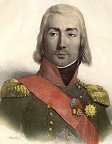 The cavalry of the Imperial Guard was commanded by Marshal Jean-Baptiste Bessieres
(1766-1813). He was a tall man, always impeccably uniformed and rigorous in discipline.
Bessieres was one of the Good Marshals, like by soldiers. "He alone kept the old-fashioned
military style of both powdering his hair and wearing it in a long queue."
The cavalry of the Imperial Guard was commanded by Marshal Jean-Baptiste Bessieres
(1766-1813). He was a tall man, always impeccably uniformed and rigorous in discipline.
Bessieres was one of the Good Marshals, like by soldiers. "He alone kept the old-fashioned
military style of both powdering his hair and wearing it in a long queue."
The combination of being calm and intrepid attracted Napoleon. According to Colonel John
Elting of US Army, Bessieres was a thorough soldier and all soldier - loyal, brave and
even-tempered, "possessing a cold courage that never flinched."
Bessiers was wounded at the battle of Wagram. Henri Lachoque writes: "At this moment
Bessieres was needed to charge Liechtenstein's cavalry - but the Marshal had just been hit. ... Bessieres was borne unconscious from the field on a litter.
His guardsmen thought he was dead and some were sobbing. All swore to avenge him.
'That was a fine shot, Bessieres' the Emperor told him later. "It made my Guard cry...'"
Georges Blond described how Bessieres was killed: " .... staff surrounded him [Bessieres] and this ciolorful
party was spotted by the gunners of an enemy battery. The first round decapitated a sergeant of the Polish light
cavalry of the escort. Bessieres, saddened, galloped toward the enemy to inspect their position more closely, then returned: 'I want this young man buried.'
Hardly had he spoken, when a round from the same battery struck him fully in the body.
Napoleon, learning shortly afterwards of his death, appeared distressed." ... When walking
away, he murmured: 'Death is coming near to us."
In Spain Bessieres ordered a reign of terror, seizing hostages and arresting magistrates and priests.
Napoleon's Escort and Duty Squadrons.
Napoleon had in his disposal 4 squadrons drawn from the four regiments
of Guard cavalry: Horse Grenadiers, Chasseurs, Dragoons and Polish lancers.
These squadrons were called "the duty squadrons".
Among the four duty squadrons the Chasseurs had a special task:
a group of 20-30 men rode in front and behind the Emperor.
 The Emperor was guarded by a squadron of Guard cavalry,
usually of the Chasseurs-a-Cheval (Horse Chasseurs).
Only on rare ocassions other troops enjoyed this priviledge.
In 1806 when the Guard couldn't catch up with the Emperor, the 1st Hussars
escorted him. The Guard was so exhausted on arrival that the hussars continued to escort
Napoleon. In the battle of Eckmuhl in 1809 the 1st Chasseurs-a-Cheval (this was line regiment,
not guard) escorted the Emperor. Shortly, also in 1809, the 1st Horse
Carabiniers enjoyed this priviledge. In 1813 after the battle of Dresden, Napoleon was
escorted by the Elite Gendarmes.
The Emperor was guarded by a squadron of Guard cavalry,
usually of the Chasseurs-a-Cheval (Horse Chasseurs).
Only on rare ocassions other troops enjoyed this priviledge.
In 1806 when the Guard couldn't catch up with the Emperor, the 1st Hussars
escorted him. The Guard was so exhausted on arrival that the hussars continued to escort
Napoleon. In the battle of Eckmuhl in 1809 the 1st Chasseurs-a-Cheval (this was line regiment,
not guard) escorted the Emperor. Shortly, also in 1809, the 1st Horse
Carabiniers enjoyed this priviledge. In 1813 after the battle of Dresden, Napoleon was
escorted by the Elite Gendarmes.
In most campaigns Napoleon had in his disposal 4 squadrons drawn from the four
regiments of Guard cavalry: grenadiers, chasseurs, Polish lancers and dragoons. These
squadrons were called "the duty squadrons". In the beginning the duty squadrons were one
each from the chasseurs and grenadiers, later augmented by the dragoons and Poles, when
they became "Old Guard".
In Leipzig in 1813 the situation was critical and Napoleon was forced to unleash the
four duty squadrons (grenadiers, Polish lancers, dragoons and chasseurs).
These 800 superb cavalrymen led by Letort "scored a brilliant victory against the Austrian
horse, including the capture of 190 officers and men of the famous Vincent [Latour]
Chevaulegers." (Parquin - "Napoleon's Victories")
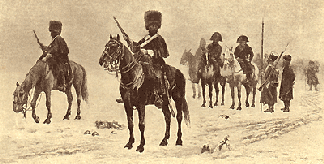 Among the four duty squadrons the Guard Chasseurs had a special task: a group of 20-30 men rode
in front and behind the Emperor, while a corporal and 4 chasseurs cleared a way for him.
One of the four carried his despatch case and another his field glass.
If the Emperor dismounted these men would immediately do likewise.
Among the four duty squadrons the Guard Chasseurs had a special task: a group of 20-30 men rode
in front and behind the Emperor, while a corporal and 4 chasseurs cleared a way for him.
One of the four carried his despatch case and another his field glass.
If the Emperor dismounted these men would immediately do likewise.
Rousselot writes: "The picket that accompanied Napoleon during his frequent excursions away from his field
Headquarters was drawn from the Chasseur service squadron and comprised a lieutenant, a marechal-des-logis,
two brigadiers, a trumpeter and 22 chasseurs, some riding in advance and some to the rear of the group immediately surrounding the Emperor.
The latter included a brigadier and 4 chasseurs, one of whom carried Napoleon's portfolio
containing his maps, writing materials and dividers, while another bore his telescope."
(There were dangers not only on the battlefield. From 1800 to 1805, a terrorist organization
led by the Bourbon Comte d'Artois and supported by the British Government, attempted no fewer
than six times to assassinate Napoleon. The most infamous was the 'infernal
machine' (ext.link) which exploded in Paris.
This horse-drawn bomb killed many people and demolished a building.)
In 1812 the Cossacks attacked Napoleon's headquarters at Gorodnia [Horodnia]. The only troops with the Emperor was
the Duty Squadron of the Polsih Guard Lancers under Kozietulski. Kozietulski's men threw themselves at the swarm of
Cossacks, Kozietulski was pierced by lance "which entered his shoulder as far as the bone." It was a dramatic fight.
There then appeared the Old Guard Horse Grenadiers in line formation and the Cossacks disappeared into the forest.
(In Museum of the Polish Army in Warsaw is exhibited his uniform with the visible hole in the sleeve and stained in blood).
The Cossacks returned in large numbers and surrounded the Red Lancers on three sides. The Dutch lost more than
100 men and the Poles lost approx. 20 killed and wounded.
Chlapowski of Guard Lancers writes: "He [Napoleon] liked to ride downhill at a rapid gallop, regardless of the risk
of a broken neck to those following him. He never used spurs nor did he use leg pressure to put
the horse into a gallop - he started it with a blow of his whip."
According to J.F. Lozier, Napoleon owned approx. 150 horses during the course of his life.
Napoleon preferred Arab horses though he often had to make do with other mounts.
His horses were schooled by Jardin, who accustomed them to every kind of object.
"He even went so far as to drive pigs and dogs between their legs."
(Georges Blond - "La Grande Armee" publ. in 1995)
List of names of some of his horses include: Austerlitz, Artaxercés, Babylonien,
Cid, Conquérant, Extrême, Euphrate, Kurde, Montevideo, Sheikh, Sahara, Triomphant, Tamerlan.
- Désirée was one of the horses ridden at Waterloo.
- Intendant was a Norman horse mainly used for parades and reviews
because of his graceful nature during such ceremonies.
- Marengo was one of the horses ridden at Waterloo.
His skeleton is kept at the National Army Museum in London. (ext.link)
- Roitelet was an English-Limousin chestnut, it was ridden
in 1813 at Lützen and in 1814 at Arcis-sur-Aube.
- Styrie was ridden by Bonaparte at Marengo.
- Tauris was a gift from Tsar Alexander of Russia (ext.link) and was ridden in 1812 by Napoleon
at Smolensk, Borodino, during his entrance in Moscow, and during the retreat from Russia.
In 1814 being brought to Elba, and in 1815 it was ridden from Golf-Juan to Paris.
- Vizir it was a gift from the Sultan of Turkey (ext.link) in 1805
and one of the Napoleon's favorites. In 1815 Napoleon brought it
with him to Saint-Helena. It now resides - stuffed - in the Musée de l'Armée in
Paris. (ext.link)
Napoleon was never the best of horsemen, and most often travelled by coach.
It was painted in green, drawn by 6 large grey horses (three ex-drivers of Guard Horse Artillery
rode on them), and had 2 coachmen on top and a servant on the box.
The coach contained pull-out bed, hand-operated printing press, his mobile treasury,
and small library. The escort of the coach was as follow: four Guard Chasseurs-a-Cheval
rode in pairs before the coach, and twelve pairs were behind it. At night 5 lamps illuminated the coach,
which gave extraordinary appearance as it raced through villages.
 In 1814 the Russian,
Prussian, and
Austrian armies entered France and after several battles reached the gates of
Paris.
Napoleon abdicated on April 6. However, occasional military actions continued in Italy, Spain, and Holland throughout
the spring of 1814. On April 7th Napoleon called for volunteers from his Old Guard to serve in his guard
on Elba Island. The Allies allowed for 500 infantrymen, 120 cavalrymen and 120 artillerymen.
Generals Petit and Pelet were soon swamped with requests. Many officers asked to serve as
simple privates. Out of the French and Polish cavalry only 100 Polish lancers were chosen.
There were additionally several hundred volunteers from infantry, 300 grenadiers and 300
chasseurs of Old Guard. These men were his escort, his protectors in thisvery difficult and sad
time.
In 1814 the Russian,
Prussian, and
Austrian armies entered France and after several battles reached the gates of
Paris.
Napoleon abdicated on April 6. However, occasional military actions continued in Italy, Spain, and Holland throughout
the spring of 1814. On April 7th Napoleon called for volunteers from his Old Guard to serve in his guard
on Elba Island. The Allies allowed for 500 infantrymen, 120 cavalrymen and 120 artillerymen.
Generals Petit and Pelet were soon swamped with requests. Many officers asked to serve as
simple privates. Out of the French and Polish cavalry only 100 Polish lancers were chosen.
There were additionally several hundred volunteers from infantry, 300 grenadiers and 300
chasseurs of Old Guard. These men were his escort, his protectors in thisvery difficult and sad
time.
Charles Parquin writes: "General Krasinski who commanded the Polish lancers ... came forward
with his officers. As he took his leave of the Emperor he uttered these words, which do the
greatest credit to his nation: "Sire, if you had mounted the throne of Poland, you would
have been killed upon it; but the Poles would have died at your feet to a man."
Krasinki wearing his parade uniform announced to his lancers that "God has visited misfortune
upon the Emperor" and all began to weep. They regreted they had not all been killed before
hearing that anyone had dared demand Napoleon's abdication. Loud cries for vengeance were
heard along with "Vive l"Empereur!" Sabers and lances were brandished and the cavalry moved
toward Fontainebleau. They passed through Nainville before Sebastiani's ADC halted them.
Troops on Elba Island:
infantry battalion (607 veteran grenadiers and chasseurs of Old Guard)
cavalry squadron (125 Polish lancers of Old Guard, and 7 chasseurs of Old Guard)
artillery battery (100 gunners of Old Guard)
"A squadron of Polish lancers under Chef d'Escadron Jerzmanowski and Major Roul -
125 men divided into a mounted company of 22 under Capitaine Schultz (a giant over 2.13
metres who was present at Waterloo); a dismounted company of 96 under Capitaine Balinski...
There was also a group of 7 chasseurs and Mamelukes commanded by Lieutenant Seraphin
(a Mameluke...) The lancers had a white standard emblazoned in crimson with the words,
'Polish Light-Horse, Napoleon Squadron' with a crowned 'N' on the reverse."
(Mark Adkin - "The Waterloo Companion" p 14)
The squadron was given a standard with the inscription 'Polish Light-Horse, Napoleon Squadron."
|
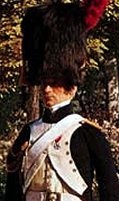 The horse grenadier (photo from Musee l'Armée):
The horse grenadier (photo from Musee l'Armée):
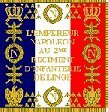

 In 1796 the Guard of the Directory was formed to escort the Directors in public ceremonies and parades. These guardsmen were 5'10" tall, literate, with perfect conduct and participated in at least 2 campaigns. These men were the elite of the army and formed 2 companies of foot grenadiers and one squadron of horse grenadiers. The horse grenadiers wore aiguillette on the right shoulder. It was the distinctive insignia of Guard cavalry.
The Guard drew extra pay and allowances, additionally they got better housing and enjoyed
the highest prestige. The guardsmen were forbidden, under pain of dismissal, to tend an
officer's horse, or even hold it by the bridle.
In 1796 the Guard of the Directory was formed to escort the Directors in public ceremonies and parades. These guardsmen were 5'10" tall, literate, with perfect conduct and participated in at least 2 campaigns. These men were the elite of the army and formed 2 companies of foot grenadiers and one squadron of horse grenadiers. The horse grenadiers wore aiguillette on the right shoulder. It was the distinctive insignia of Guard cavalry.
The Guard drew extra pay and allowances, additionally they got better housing and enjoyed
the highest prestige. The guardsmen were forbidden, under pain of dismissal, to tend an
officer's horse, or even hold it by the bridle.
 In 1806 was formed third regiment, the Guard Dragoons -->
In 1806 was formed third regiment, the Guard Dragoons --> Picture: Guard Dragoons and Napoleon in burning Moscow, 1812.
Picture: Guard Dragoons and Napoleon in burning Moscow, 1812.
 The cavalry of the Imperial Guard was commanded by Marshal Jean-Baptiste Bessieres
(1766-1813). He was a tall man, always impeccably uniformed and rigorous in discipline.
Bessieres was one of the Good Marshals, like by soldiers. "He alone kept the old-fashioned
military style of both powdering his hair and wearing it in a long queue."
The cavalry of the Imperial Guard was commanded by Marshal Jean-Baptiste Bessieres
(1766-1813). He was a tall man, always impeccably uniformed and rigorous in discipline.
Bessieres was one of the Good Marshals, like by soldiers. "He alone kept the old-fashioned
military style of both powdering his hair and wearing it in a long queue."
 The Emperor was guarded by a squadron of Guard cavalry,
usually of the Chasseurs-a-Cheval (Horse Chasseurs).
Only on rare ocassions other troops enjoyed this priviledge.
In 1806 when the Guard couldn't catch up with the Emperor, the 1st Hussars
escorted him. The Guard was so exhausted on arrival that the hussars continued to escort
Napoleon. In the battle of Eckmuhl in 1809 the 1st Chasseurs-a-Cheval (this was line regiment,
not guard) escorted the Emperor. Shortly, also in 1809, the 1st Horse
Carabiniers enjoyed this priviledge. In 1813 after the battle of
The Emperor was guarded by a squadron of Guard cavalry,
usually of the Chasseurs-a-Cheval (Horse Chasseurs).
Only on rare ocassions other troops enjoyed this priviledge.
In 1806 when the Guard couldn't catch up with the Emperor, the 1st Hussars
escorted him. The Guard was so exhausted on arrival that the hussars continued to escort
Napoleon. In the battle of Eckmuhl in 1809 the 1st Chasseurs-a-Cheval (this was line regiment,
not guard) escorted the Emperor. Shortly, also in 1809, the 1st Horse
Carabiniers enjoyed this priviledge. In 1813 after the battle of  Among the four duty squadrons the Guard Chasseurs had a special task: a group of 20-30 men rode
in front and behind the Emperor, while a corporal and 4 chasseurs cleared a way for him.
One of the four carried his despatch case and another his field glass.
If the Emperor dismounted these men would immediately do likewise.
Among the four duty squadrons the Guard Chasseurs had a special task: a group of 20-30 men rode
in front and behind the Emperor, while a corporal and 4 chasseurs cleared a way for him.
One of the four carried his despatch case and another his field glass.
If the Emperor dismounted these men would immediately do likewise.
 In 1814 the
In 1814 the  Picture: Eagle-Bearer of Horse Grenadiers [Grenadiers-a-cheval de la Garde]
in parade uniforms, by Rousellot. For parade their horses were decorated with red,
braided forelocks and crupper rosettes.
Picture: Eagle-Bearer of Horse Grenadiers [Grenadiers-a-cheval de la Garde]
in parade uniforms, by Rousellot. For parade their horses were decorated with red,
braided forelocks and crupper rosettes.
 There were also candidates from the dragoons, chasseurs and even some hussars. For example
the scarface Guindey, NCO of the 10e Hussars, who killed Prince Louis Ferdinand
of Prussia in 1806. (He was killed in 1813 at Hanau by the Bavarians.)
There were also candidates from the dragoons, chasseurs and even some hussars. For example
the scarface Guindey, NCO of the 10e Hussars, who killed Prince Louis Ferdinand
of Prussia in 1806. (He was killed in 1813 at Hanau by the Bavarians.)

 The Horse Grenadiers rode on big black horses, with full manes and tails, bought in Caen for 680 francs apiece.
Their daily ration was 10 pounds of hay, 15 of straw, and 2/3 bushel of oats or 1/3 of bran.
The Horse Grenadiers rode on big black horses, with full manes and tails, bought in Caen for 680 francs apiece.
Their daily ration was 10 pounds of hay, 15 of straw, and 2/3 bushel of oats or 1/3 of bran.

 Left: parade uniform in 1800-1807.
It was also called the First Full Dress and consisted of dark blue jacket, white lapels and
red cuffs.
Left: parade uniform in 1800-1807.
It was also called the First Full Dress and consisted of dark blue jacket, white lapels and
red cuffs.
 Left: in 1809 the surtout was replaced by
so-called Second Full Dress (or "undress habit"). It was made of cheaper clothes
than the First Full Dress. The Second Uniform had the plain round cuffs of the surtout
and white lapels of the First Uniform. This outfit was very popular and was worn at Borodino,
Leipzig, etc. The First Full Dress was for parade only and the Second Full Dress for campaign.
Left: in 1809 the surtout was replaced by
so-called Second Full Dress (or "undress habit"). It was made of cheaper clothes
than the First Full Dress. The Second Uniform had the plain round cuffs of the surtout
and white lapels of the First Uniform. This outfit was very popular and was worn at Borodino,
Leipzig, etc. The First Full Dress was for parade only and the Second Full Dress for campaign.
 Right: after Napoleon's abdication in 1814 the grenadiers
had been given the new, short tailed habit-veste in anticipation of their receiving
armor, like cuirassiers and horse carabiniers. The new dark blue jackets were piped in red along the front
opening. This coat was worn only at Ligny and Waterloo.
Right: after Napoleon's abdication in 1814 the grenadiers
had been given the new, short tailed habit-veste in anticipation of their receiving
armor, like cuirassiers and horse carabiniers. The new dark blue jackets were piped in red along the front
opening. This coat was worn only at Ligny and Waterloo.
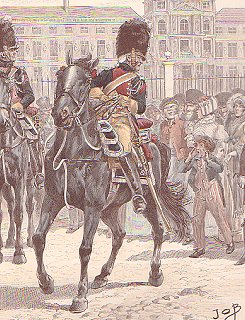 In 1801 Bonaparte organized an elite legion of gendarmes. It consisted of a large staff,
2 squadrons of horse gendarmes and 2 companies of foot gendarmes. In 1807 there were 2
squadrons of Elite Gendarmes. (There was also one battalion of foot gendarmes in the Guard).
In 1801 Bonaparte organized an elite legion of gendarmes. It consisted of a large staff,
2 squadrons of horse gendarmes and 2 companies of foot gendarmes. In 1807 there were 2
squadrons of Elite Gendarmes. (There was also one battalion of foot gendarmes in the Guard).
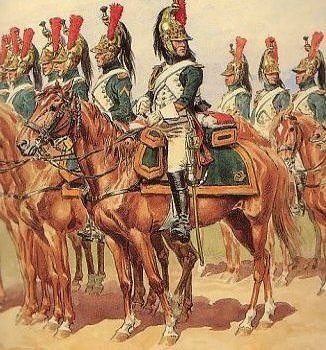 The Regiment of Guard Dragoons was established in April 1806.
In each of the 30 dragoon regiments was made a list of 6 NCOs and privates as candidates to
the Guard.
The Regiment of Guard Dragoons was established in April 1806.
In each of the 30 dragoon regiments was made a list of 6 NCOs and privates as candidates to
the Guard.  Letort was one of the commanders of Guard Dragoons. He was a daredevil of Lasalle's ilk.
In 1814 at Rheims he "led his Guard Dragoons as though they were the
Letort was one of the commanders of Guard Dragoons. He was a daredevil of Lasalle's ilk.
In 1814 at Rheims he "led his Guard Dragoons as though they were the 
 Napoleon intended to mount the dragoons on black horses but Bessieres, commander of Guard
cavalry, pointed out that blacks were designated only for the Horse Grenadiers and for the Elite
Gendarmes. He instructed the commander of dragoons to procure chestnuts. Originally the
first two squadrons rode on catured Prussian Gendarmes' horses, the other two squadrons were
still on foot. Later on all dragoons were mounted on French, Prussian and Austrian chestnuts
(there were also some bays).
Napoleon intended to mount the dragoons on black horses but Bessieres, commander of Guard
cavalry, pointed out that blacks were designated only for the Horse Grenadiers and for the Elite
Gendarmes. He instructed the commander of dragoons to procure chestnuts. Originally the
first two squadrons rode on catured Prussian Gendarmes' horses, the other two squadrons were
still on foot. Later on all dragoons were mounted on French, Prussian and Austrian chestnuts
(there were also some bays).
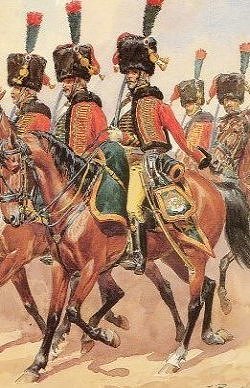 As commander of the army in Italy, Bonaparte took over the guides he found at Albenga in 1796.
Though they fought with distinction at Mondovi and Lodi, they guarded Bonaparte poorly.
In 1796 at Borghetto, Bonaparte was lunching with general Massena and Murat when the
As commander of the army in Italy, Bonaparte took over the guides he found at Albenga in 1796.
Though they fought with distinction at Mondovi and Lodi, they guarded Bonaparte poorly.
In 1796 at Borghetto, Bonaparte was lunching with general Massena and Murat when the 
 The Guard Chasseurs rode on 15 hands tall (149-153 cm) pictoresque bays.
They were mostly dark bays. Some sources, for example L. Rousselot, mention bays and
chestnuts. One author gives chestnuts for the squadrons of Young Guard.
The Guard Chasseurs rode on 15 hands tall (149-153 cm) pictoresque bays.
They were mostly dark bays. Some sources, for example L. Rousselot, mention bays and
chestnuts. One author gives chestnuts for the squadrons of Young Guard.
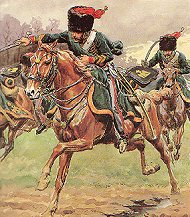 In 1812-14 the overalls were grey with aurore stripes and with leather reinforcing between the legs and around the
bottom. (See picture -->)
In 1812-14 the overalls were grey with aurore stripes and with leather reinforcing between the legs and around the
bottom. (See picture -->)
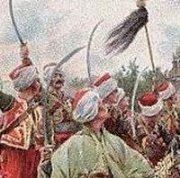 In 1802, after reading general Rapp's report, Bonaparte decided to form a squadron of Mameluks
organized like hussars. Napoleon decided that the valiant cavaliers with dark skins would
help to reinforce his own prestige. The sons of the desert or "authentic head-hunters"
received a hot welcome in Paris. The officers were Frenchmen, the commander was Jean Rapp,
a daredevil with 22 wounds.
In 1802, after reading general Rapp's report, Bonaparte decided to form a squadron of Mameluks
organized like hussars. Napoleon decided that the valiant cavaliers with dark skins would
help to reinforce his own prestige. The sons of the desert or "authentic head-hunters"
received a hot welcome in Paris. The officers were Frenchmen, the commander was Jean Rapp,
a daredevil with 22 wounds.
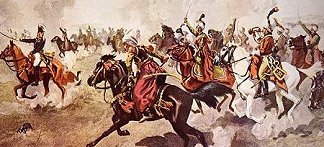 In Austerlitz (1805) the Allies had gained a healthy respect for the colorfully clad
Mamelukes, and their proud reputation within the army was assured.
In Austerlitz (1805) the Allies had gained a healthy respect for the colorfully clad
Mamelukes, and their proud reputation within the army was assured.
 "The Guard's first foreign regiment was the chevau-legers Polonais, activated in
March 1807 from picked volunteers, mostly small landowners or their sons, who had some
education and were expert riders. They paid for their own clothing and equipment and provided their own horses.
Nevertheless, the regiment was recruited up to strength in 10 days.
Their two majors, captain-instructor, two adjutant-majors, quartermaster-treasurer,
surgeon, and all their trumpeters were French.
"The Guard's first foreign regiment was the chevau-legers Polonais, activated in
March 1807 from picked volunteers, mostly small landowners or their sons, who had some
education and were expert riders. They paid for their own clothing and equipment and provided their own horses.
Nevertheless, the regiment was recruited up to strength in 10 days.
Their two majors, captain-instructor, two adjutant-majors, quartermaster-treasurer,
surgeon, and all their trumpeters were French.
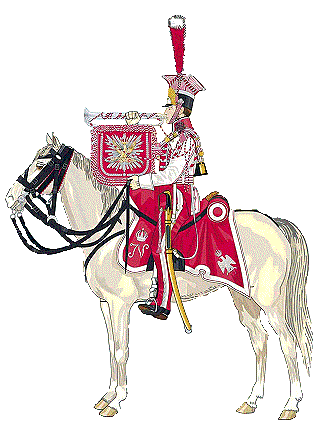 In 1812 when during the pursuit of Cossacks one of the lancers lost his headwear, officer Jerzmanowski ordered him to go back and retrieve it to prevent the enemy from claiming any trophy taken from this regiment. It was quite unusual since many troops panicked before Cossacks and abandoned not only their baggage and weapons but also even
their wounded comrades. The Cossacks were evrywhere. At Katyn the Poles had great difficulty
getting rid of several hundred scouting in front of a mass of Russian cavalry. Lahy ! Lahy ! (Poles in old Russian)
the Russians cried, firing off their carbines at some distance from the leading squadron to provoke the
Guard Lancers. 'Never get into a skirmish with Cossacks' was the Poles' advice. However a
formal charge sent them flying.
In 1812 when during the pursuit of Cossacks one of the lancers lost his headwear, officer Jerzmanowski ordered him to go back and retrieve it to prevent the enemy from claiming any trophy taken from this regiment. It was quite unusual since many troops panicked before Cossacks and abandoned not only their baggage and weapons but also even
their wounded comrades. The Cossacks were evrywhere. At Katyn the Poles had great difficulty
getting rid of several hundred scouting in front of a mass of Russian cavalry. Lahy ! Lahy ! (Poles in old Russian)
the Russians cried, firing off their carbines at some distance from the leading squadron to provoke the
Guard Lancers. 'Never get into a skirmish with Cossacks' was the Poles' advice. However a
formal charge sent them flying. 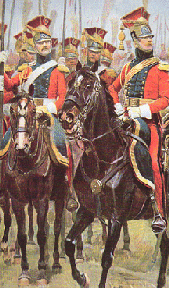 The Regiment of Red Lancers was formed in 1810 from three Dutch troops:
The Regiment of Red Lancers was formed in 1810 from three Dutch troops: Pierre Eduard Colbert was the colonel of the Red Lancers.
Marshal Ney described Colbert as "consummate officer of the greatest distinction."
Colbert earned the nickname "Iron Man" on many battlefields.
Some found him domineering and tactless. In 1814, in a report presented to the Burbons
he was described as "skilled and distinguished in all disciplines."
Colbert earned the nickname "Iron Man" on many battlefields.
Bullet wound to arm (Egypt), bullet wound to thigh (Austerlitz)
three lance wounds (Eastern Prussia 1807), bullet wound to head (
Pierre Eduard Colbert was the colonel of the Red Lancers.
Marshal Ney described Colbert as "consummate officer of the greatest distinction."
Colbert earned the nickname "Iron Man" on many battlefields.
Some found him domineering and tactless. In 1814, in a report presented to the Burbons
he was described as "skilled and distinguished in all disciplines."
Colbert earned the nickname "Iron Man" on many battlefields.
Bullet wound to arm (Egypt), bullet wound to thigh (Austerlitz)
three lance wounds (Eastern Prussia 1807), bullet wound to head (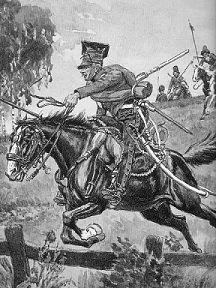 Paul Britten-Austin writes that the Dutchmen are "too phlegmatic" for the little warfare.
Austin writes: "Approaching stealthily, Cossacks nevertheless (again) carry off the Dutch
regiment's outpost picket. And again 'only one man escaped flat out at a gallop and brought
the news to our camp. Even an hour and a half's pursuit couldn't catch up with the Cossacks.'
Mortified by this second surprise of the campaign, Colbert doubles the 2nd Regiment's
outposts; and, to make assurance doubly sure, mingles the Dutchmen with the warier,
more experienced
Paul Britten-Austin writes that the Dutchmen are "too phlegmatic" for the little warfare.
Austin writes: "Approaching stealthily, Cossacks nevertheless (again) carry off the Dutch
regiment's outpost picket. And again 'only one man escaped flat out at a gallop and brought
the news to our camp. Even an hour and a half's pursuit couldn't catch up with the Cossacks.'
Mortified by this second surprise of the campaign, Colbert doubles the 2nd Regiment's
outposts; and, to make assurance doubly sure, mingles the Dutchmen with the warier,
more experienced  In 1815, just few weeks before Waterloo, Napoleon wrote: "As soon as possible the Red Lancers must be increased to
3 regiments..." This however didn't happen, the time was too short.
It was only one regiment as they lacked horse and men, and even accepted cavalrymen from different sources: Royal
Corps, retirement, Young Guard and even some horse grenadiers.
In 1815, just few weeks before Waterloo, Napoleon wrote: "As soon as possible the Red Lancers must be increased to
3 regiments..." This however didn't happen, the time was too short.
It was only one regiment as they lacked horse and men, and even accepted cavalrymen from different sources: Royal
Corps, retirement, Young Guard and even some horse grenadiers.
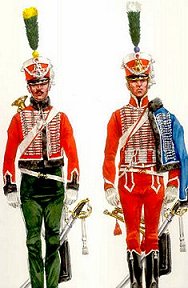 In 1813 there were 15.000 volunteers with 20.000 horses, mounted and equipped at their own
expense. These 20-26 years old men came mainly from noble and wealthy families but were
hardly enthusiastic for military service and soon many deserted. They formed new regiments
named Life Guard but because of the desertions it was changed to Honor Guard.
In 1813 there were 15.000 volunteers with 20.000 horses, mounted and equipped at their own
expense. These 20-26 years old men came mainly from noble and wealthy families but were
hardly enthusiastic for military service and soon many deserted. They formed new regiments
named Life Guard but because of the desertions it was changed to Honor Guard. 